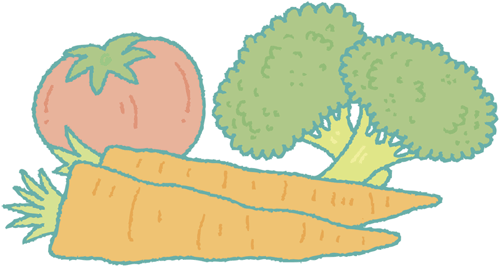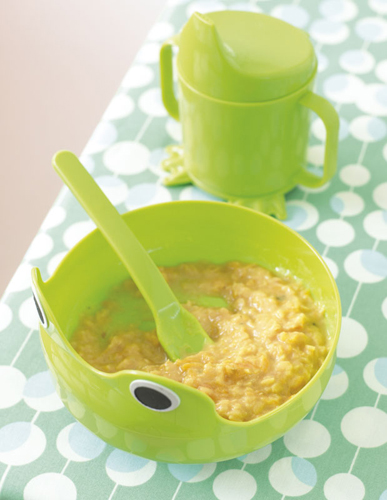Whether your baby has a special diet for religious or cultural reasons, lifestyle choices, or food allergies, it is possible to offer diverse and healthy food with all of the important nutrients. Babies have slightly different needs than adults, so if there are foods you wish to avoid, it’s a good idea to get advice from a dietitian.
| Q: |
Can my baby get all the nutrients she needs from a vegetarian diet?
| | A: |
If your baby is on a follow-on formula, you do not need to be
worried about nutrients in her vegetarian diet. It is, however, good
practice to ensure that she begins to eat plenty of iron and vitamin
B12-rich foods, and this is essential if your baby is breastfed. If your
family eats eggs, shellfish, or fish, this can be a good way to top off
levels; otherwise look for fortified cereals or soy products, which
have the vitamin added. Good levels of iron are found in leafy greens as
well as dried fruits, chickpeas, and baked beans. Your baby will also
require additional vitamin D, but fortunately many products are
fortified with this key vitamin; spending just a little time outside in
the sunlight will also help.
|

| Q: |
Are fruits and vegetables alone sufficient for my baby?
| | A: |
Fruits and vegetables offer an amazing number of nutrients,
including vitamins and minerals. They don’t, in general, offer much in
terms of fat, protein, iron, or calcium, and these food groups are very
important for growth and development. It’s a good idea to mix vegetables
with a cheese sauce.
While your baby’s
regular milk will supply him with the missing bits of his diet in the
short-term, he will need much more than fruits and vegetables when he is
eventually weaned from his milk diet at around 12–18 months.
|
| Q: |
Are there any vegetables that are not appropriate for babies?
| | A: |
Some babies have difficulties with onions, cabbage, garlic, and
other gas-inducing vegetables, but small amounts are often acceptable,
and this is a problem that is usually resolved within a few months.
Deadly nightshade vegetables, such as peppers and eggplant, can
sometimes cause discomfort, but this is rare, and it’s worth persevering
unless she experiences worrying symptoms.
|
| Q: |
What do I need to add to my baby’s vegan diet to be sure he’s getting enough nutrients?
| | A: |
If your baby is on follow-on formula, there is no need for
concern. However, if you’re breastfeeding your baby, you need to ensure
he has plenty of iron and vitamin B12 in his diet (see advice on
vegetarian diets, Can my baby get all the nutrients she needs from a vegetarian diet?), as well as a vitamin D supplement.
It is a good idea to
introduce him to the foods that will become a big part of his diet, such
as legumes, leafy green vegetables, soy proteins, and whole grains so
that they become familiar and acceptable. It’s also important to
introduce seeds and nuts (the latter in “butter” form, to prevent
choking), to add essential nutrients and protein to your baby’s diet.
There has been a lot in the news lately about vegan babies failing to
grow and develop properly, so you may want to seek some specialist help
from a dietitian to ensure that your baby’s needs are met.
|
| Q: |
Is wild or brown rice appropriate for babies at this stage?
| | A: |
Your baby’s digestive system is still quite immature, and can
struggle with foods that are very high in fiber, such as wild or brown
rice, and other whole grains. That doesn’t mean they can’t be
introduced, it simply means that they should be offered in moderation.
In the early days, it is a good idea to purée or grind them so that they
can be more easily digested. Offer them with protein, such as your
baby’s usual milk, or a little cheese, butter, or yogurt, as these can
slow down their transit through the digestive system, and give your
baby’s body more time to digest them. They are both nutritious whole
grains, and a couple of tablespoons every few days is fine.
|
| Q: |
My baby has an allergy to fish. How can we be sure she gets EFAs?
| | A: |
Essential fatty acids (EFAs) are crucial for brain and nervous
system growth and development, and there is some evidence to suggest
that they affect infants’ concentration and mood .
Oily fish is the best
source of EFAs, but if your baby is allergic to fish, the next best
thing is to use seeds and their oils. You can “lace” your baby’s meals
with natural oils, such as flaxseed (linseed), pumpkin, sesame, and
sunflower seed oils. Drizzle some into her smoothies, or onto pasta, or
mix it into a dip for her lightly steamed vegetable crudités. You can
also buy eggs that are rich in omega-3s, as the hens are fed a special
diet that includes oil-rich seeds. A well-cooked scrambled egg made from
these provides a source of EFAs.
|
Grind some seeds
Ground seeds are a good
addition to your baby’s diet since they are a great source of protein
and will provide important essential fatty acids to aid your baby’s
growth as well as her neural and brain development. Add them to any
purée for extra flavor and texture, or dot them on toast fingers or rice
cakes for added crunch and nutrition.
Red Lentils with Carrot and Tomato
Carrots are a good source of antioxidants, and tomatoes contain lycopene, which is also a strong antioxidant. Quick-cooking red lentils are a good source of folate, fiber, and iron, so all together these ingredients make a power-packed orange purée.

5 minutes
25 minutes
1 tbsp sunflower or olive oil 2 large tomatoes, skinned , seeds removed, and chopped 2 carrots, grated 1/4 tsp ground coriander 1/4 tsp ground cumin (optional) 2/3 cup red lentils 1 cup canned coconut milk 11/4 cups vegetable stock, or water
Heat the oil in a
saucepan and sauté the tomatoes and carrots gently, stirring, until
softened, about 5 minutes. Stir in the coriander and cumin, if using,
and cook for 30 seconds. Add the lentils, coconut milk, and stock, and
stir well to mix.
Bring to a boil,
then reduce the heat, cover, and simmer very gently, stirring
occasionally, until the lentils are soft, about 20 minutes. Add 1–2 tbsp
water if the mix gets too dry during cooking.
Cool slightly, then transfer to a blender and blend to a purée. Alternatively, mash to the desired consistency. Serve warm.
The purée can be
frozen in individual portions; when needed, thaw for about 1 hour at
room temperature, or about 1 minute in the microwave on medium-low, then
reheat until piping hot. Stir and let cool slightly before serving.
|